Bydgoszcz 2012-01-18
Airport in Bydgoszcz - Szwedowo.
Geographic coordinates: 53.096N 17.978E. Elevation 72 m.
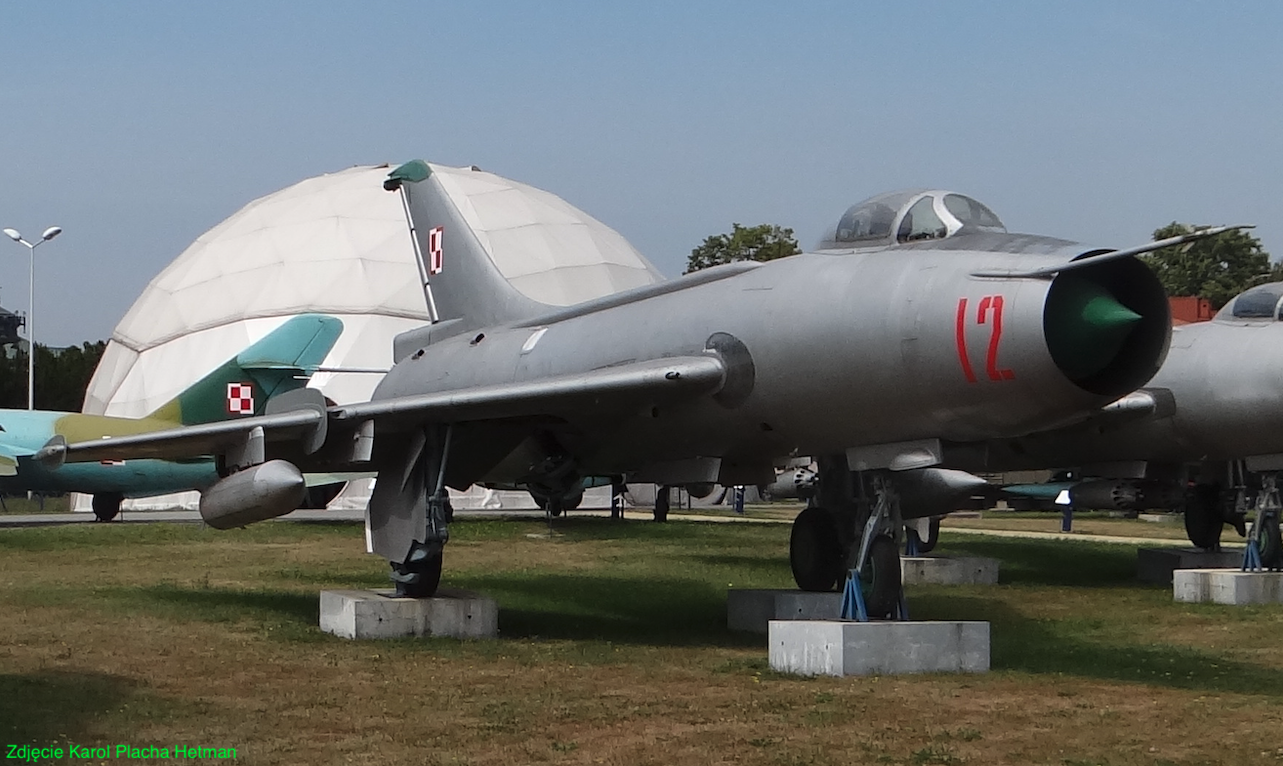
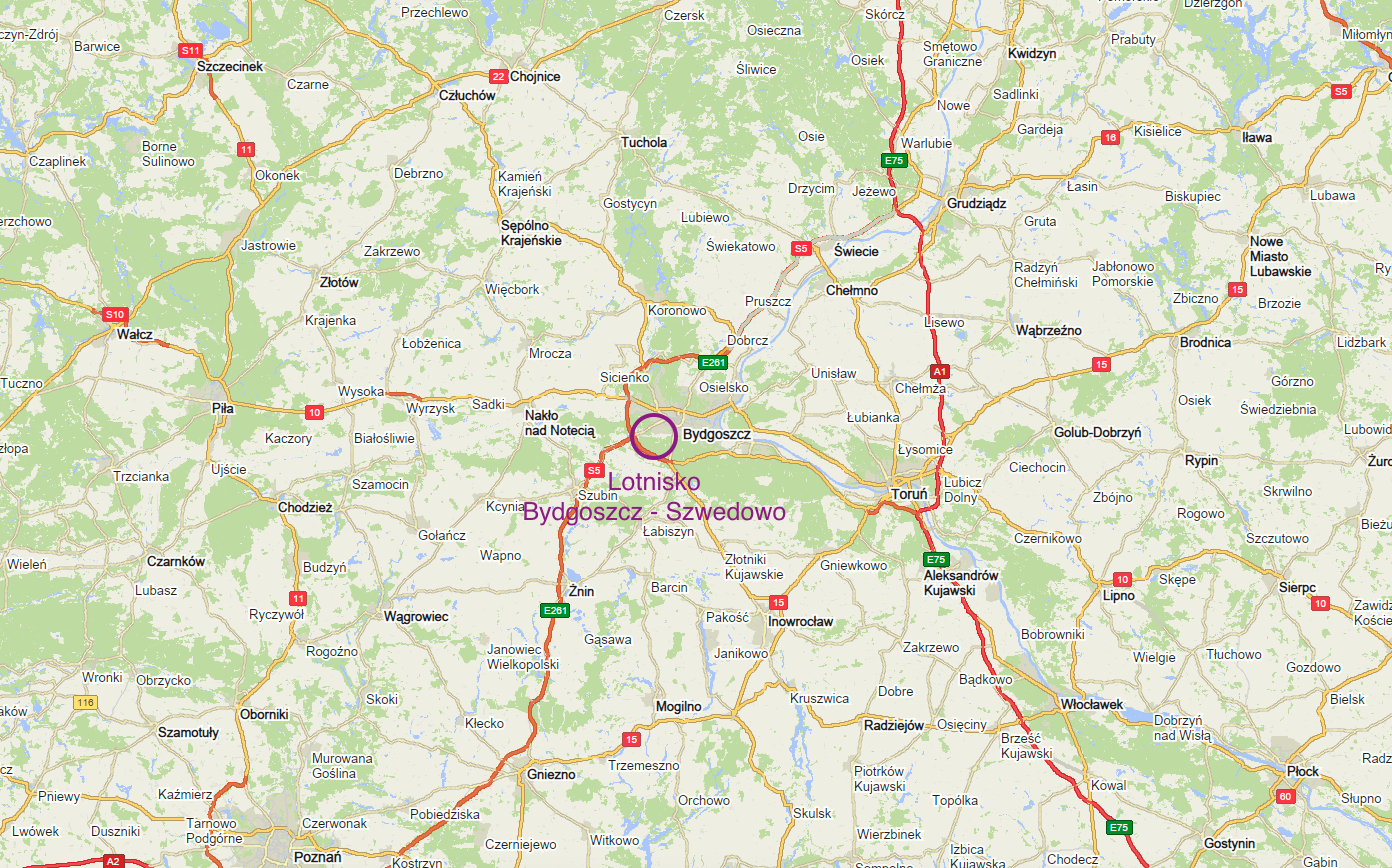
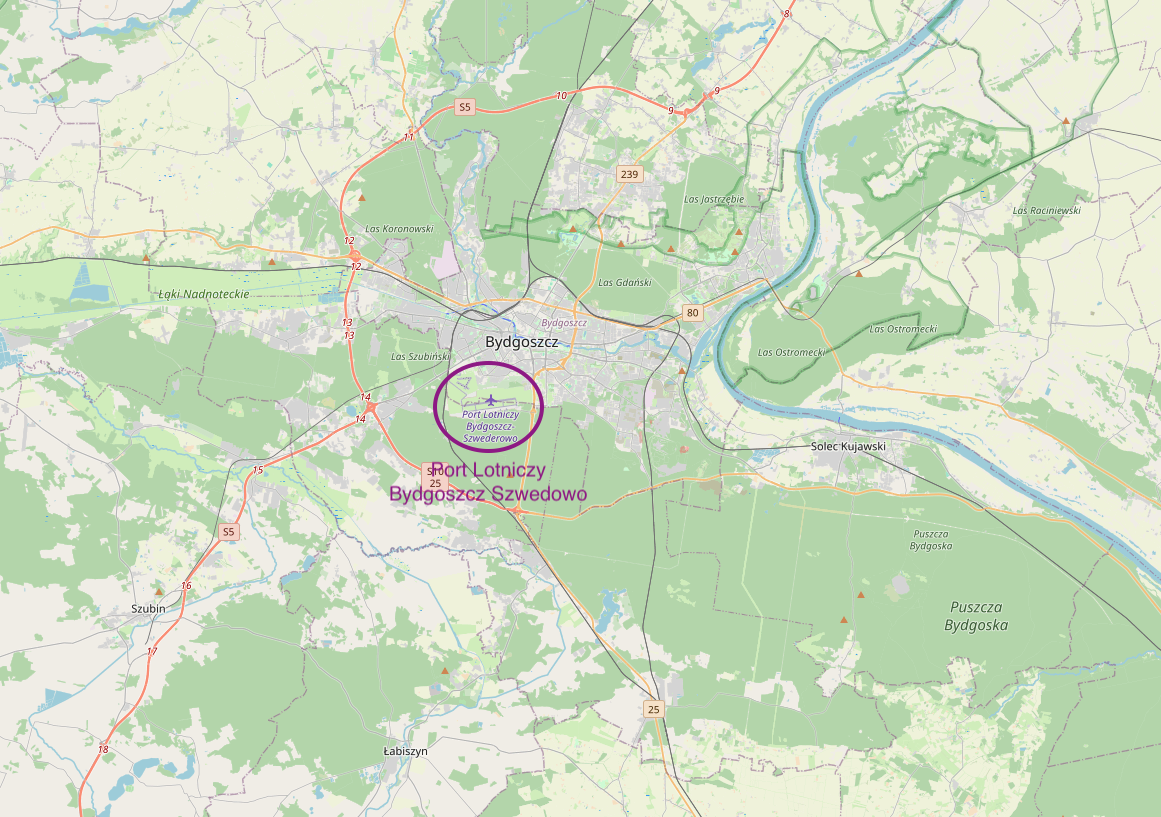
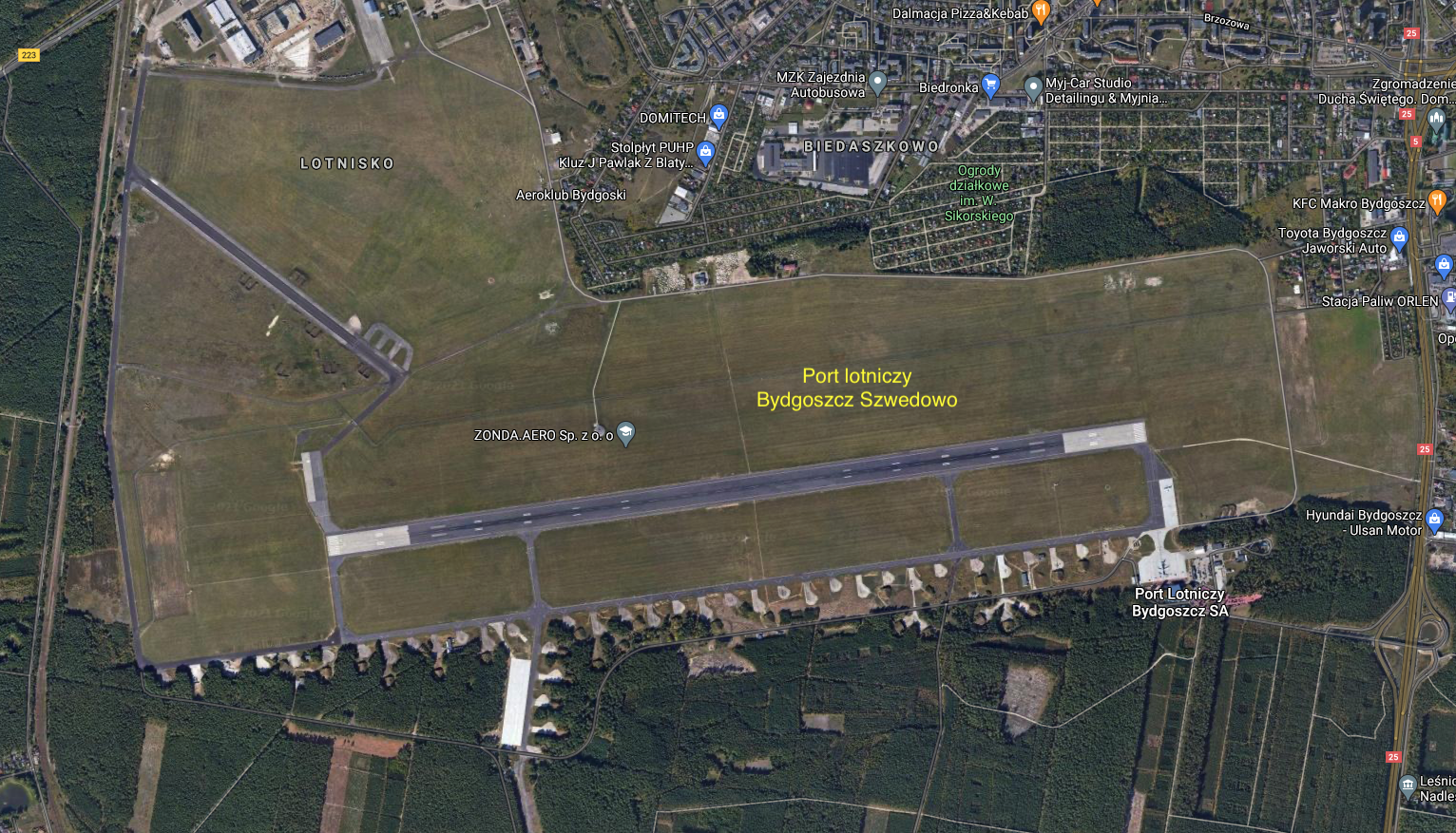
Bydgoszcz airport.
The airport in Bydgoszcz is located in the southern part of the city. For many years, the airport was used by the military, and currently (2013) it serves as a civilian airport.
The airport was founded in 1916, during the Great World War. The airport occupied approximately 112 hectares, of which approximately 88 hectares was the take-off area. In the period 1916 - 1917, four steel and glass hangars were built. By the end of 1918, it had been built; barracks, warehouses, workshops, apartments for staff, offices (headquarters) for the command, gas stations and others. A railway siding was added from the Bydgoszcz-Inowrocław route.
In 1918, there were only 14-16 planes, 10 staff and about 100 ground staff at the airport. Most of them were Poles. There was an air observer school. At the outbreak of the Greater Poland Uprising, two Polish pilots (Antoni Bartkowiak and Alojzy Błażyński), who served in the unit, escaped to the Greater Poland insurgent units.
The borders of the reborn Republic of Poland were won by Poles in battle. They were gradually confirmed on the basis of the ratified Treaty of Versailles. In January 1920, Bydgoszcz officially returned to Poland, even though the nearest border with the Prussians was over 70 km away. The Polish authorities took over the airport along with the buildings and infrastructure. However, equipment, machines, devices, spare parts, fuels, oils and greases were taken away by the Germans.
In the independent Republic of Poland.
The war did not destroy the infrastructure of the airport in Bydgoszcz. The airport was never bombed. The airport was one of the largest airports in the Republic of Poland, but it was empty. Poznań was relocated relatively quickly; 10th Intelligence Squadron (12 Breguet aircraft) and 15th Fighter Squadron (12 Spad and Fokker aircraft). Both squadrons were soon sent to the eastern front of the war against Bolshevik troops. In August 1920, the 1st Pilot School, moved from Dęblin, was located at the Airport. Another school was moved from Kraków (1920). It was the Lower Pilot School. In 1921, the schools were merged and turned into a training center for pilots, observers, gunners and mechanics. Soon, the center was named Pilot School in Bydgoszcz. In later years, the school underwent a number of reorganizations, transformations and name changes. Since the mid-20th century, the training of professional aviation non-commissioned officers in various specialties has been centralized here. Finally, at the end of the 30-year period, the Bydgoszcz airport was home to the Aviation Training Center No. 2, which included three aviation schools: the Aviation Cadet School - technical group in Warsaw, the Aviation Non-Commissioned Officers School for Minors, and the Aviation Training Battalion in Świecie. Due to the threat of another war provoked by the Germans, in October 1938, the Aviation Non-Commissioned Officers School for Minors was moved to Krosno, where, by order of the Ministry of Military Affairs, a new aviation personnel training center was to be established. At the pilot school in Bydgoszcz, officers and non-commissioned officers learned primarily basic piloting in one-year courses. In the first years of the school's existence, the so-called Polish piloting school was developed, based on French models. In the winter there was a theoretical course, and in the spring and summer season there was practical training on, among others, Bartel, RWD, Breguet, Potez aircraft. In total, approximately 1,000 officers, non-commissioned officers and privates were trained at the Bydgoszcz airport over the last twenty years. The most famous instructor-pilots in Bydgoszcz included: Maj. pil. Jerzy Józef Wieniawa-Długoszewski, lieutenant pilot Franciszek Żwirko (graduate of the Bydgoszcz school in 1923), Stanisław Skarżyński, Bolesław Orliński, Karol Pniak, Stanisław Płonczyński, Stanisław Rogalski, Zygmunt Puławski. In the interwar period, Bydgoszcz was one of the five strong centers of military aviation training; Grudziądz, Dęblin, Ławica and Toruń. Until 30 years ago, aviation training organized by LOPiP (Air and Anti-Gas Defense League) developed.
In addition to the military school, the first Civil School of Aviation Mechanics in the country was established at the Airport in 1926, based on the military School of Aviation Mechanics operating since 1922 and the mechanical department at the State Industrial School in Bydgoszcz. Several hundred students studied at the school, and lectures were given by professors of the State Industrial School in Bydgoszcz and instructors of the Central Aviation Non-Commissioned Officers School. From this school came many highly qualified aircraft mechanics who demonstrated extraordinary skills in fighting the German occupiers during World War II. From 1933 to 1963, there was also a Glider School in Fordon near Bydgoszcz, which in the interwar period educated about 10% of glider pilots in Poland, and after the war another 4,211 graduates.
Also in the interwar period, regular air connections from Bydgoszcz to other cities began. From June 1, 1929, to September 11, 1933, Bydgoszcz maintained a direct or indirect air connection with Warsaw, Katowice, Krakow, Lviv, Poznań and Gdańsk. Flights were also made to friendly Romania (Bucharest, Galacz).
The combat squadrons returned to Bydgoszcz just before the aggression of the Germanic army on the Republic of Poland on September 1, 1939, and took part in the defensive war.
The Second World War.
During the German occupation, Luftwaffe recruits were trained at the Bydgoszcz airport, and in the period 1942 - 1945, a reserve close reconnaissance squadron was stationed here. During the occupation, there was a Conspiracy School for Minors of Aviation in Bydgoszcz, headed by pilot commander Benedykt Dąbrowski. The youth of this school stormed the airport just before the Red Army entered the city. Because the front was advancing very quickly, the Soviets did not capture the airport.
In a new reality.
When Berlin was captured on May 2, 1945, all units of the new Polish Army were ordered to return to Poland. The Poles were not given a chance to meet the Allies coming from the west or take part in the victory parade. Four so-called airport hubs have been designated for aviation units: Bydgoszcz, Inowrocław, Kutno and Tomaszów Mazowiecki. On May 10, 1945, the 3rd PLSz (Assault Aviation Regiment) together with the 2nd PNB "Kraków" (Night Bomber Regiment) was transferred to the Bydgoszcz Airport. Both units undertook further training of pilots and mechanics here. Let us remember that most of the command staff are former CCCP citizens. At that time, the 73rd Airport Maintenance Battalion was responsible for the airport. Many units were disbanded, but the 3rd PLSz remained. The divisions were disbanded and the regiments came under the direct command of the Air Force. This situation doesn't last long. On January 24, 1946, the Order of the Supreme Commander of the Polish Army was published. Pursuant to this order, the 2nd Air Attack Division was established; 4. PLSz - previously 2. PNB "Kraków", 5. PLSz - previously 3. PLSz, 6. PLSz - unit taking part in World War II, 7. PBN (Dive Bomber Regiment) in Łęczyca, then at the Ławica airport.
The numbers 1, 2, 3 were assigned to the Fighter Aviation Regiments. There were plans to create three fighter units, three attack units and one bomber unit. A new structure and command system of a "sovereign" country were to be created. All these changes took place pursuant to Order No. 019/Org of the Supreme Commander of the Polish Army of January 22, 1946, and Order No. 08 of the Commander of Polish Army Aviation of January 24, 1946.
4 PLSz and 5 PLSz operated jointly from the airport in Bydgoszcz. For the duration of the general reconstruction of the airport in Bydgoszcz, both regiments were moved to the Lublinek airport in Ruda Pabianicka (now Łódź).
However, the second half of the 40 years was a very difficult period for the Polish Nation. We were under increasingly strong Soviet domination. Many of our compatriots could not return to the country, and those who returned were harassed, often imprisoned and often sentenced to death for alleged espionage. This fate did not spare Polish pilots fighting in the West. Soviet officers ruled the Polish commands, and their equal was communists with Polish origins.
When it comes to flying equipment, the situation was bad. Machines that took part in the war were still used. New planes appeared only in February 1949, in the form of the not very modern design of the Il-10 type and its Czechoslovak license B-33. What's worse, there was no sight of modern attack equipment, because Moscow was not carrying out any work on a modern attack aircraft.

At the beginning of the 50s, due to the Korean War, there were significant changes in the aviation structure. Aviation has grown organizationally. New tactical units were established, including the 8th Air Attack Division. In September 1950, the 5th PLSz, temporarily based in Elbląg, was subordinated to the 8th DLSz. This happened pursuant to Order No. 070/Org. Ministry of National Defense of July 11, 1950, and Order of the Commander of the Air Force No. 0160/Org. Of September 1, 1950. Temporarily, in the period from May 1, 1952 to November 1, 1952, on the basis of the 5th PLSz, the Command of the 13th Air Attack Division, the 50th PLSz, the 66th Signal Company and the 56th Mobile Aviation Repair Workshop were established in Elbląg. The above-mentioned units, together with the 51st PLSz, formed in Gdańsk-Wrzeszcz, were subordinated to the Command of the 13th DLSz, pursuant to Order No. 0096/Org. Ministry of National Defense of December 11, 1951. However, it was beyond the capabilities of our country and this organization was abandoned. The 5th PLSz returned to the command of the 8th DLSz. Other units of this compound; The 13th DLSz was ultimately not established, so the 50th PLSz was not created, and the 51st PLSz was subordinated to the Command of the 16th DLSz, pursuant to Order No. 0078/Org. Ministry of National Defense of November 19, 1952.
The first half of the 50 years was a period of turbulent development of fighter aviation, but attack aviation equipment remained in the shadow. It was only around 1954 that the first turbojet-powered aircraft appeared in attack aviation regiments. These were primarily MiG-15 / Lim-1 aircraft withdrawn from fighter aviation regiments. At the same time, the piston Il-10 (B-33) remained in service until 1960.
In 1957, organizational changes took place in the Polish Military Aviation. The beginning of the changes was the establishment of the Warsaw Pact. As a result, among others, Operational Aviation was established, which during the "W" period would become the Air Army operating outside Poland. Without going into the complicated period of changes, let's focus on the 5th PLSz.
In Operational Aviation there was the 3rd KLMiesz (Mixed Aviation Corps). It included the 8th DLSz (Assault Aviation Division). The division, in turn, had in its composition; 4. PLSz in Bydgoszcz, 5. PLSz in Bydgoszcz, 48. PLSz in Inowrocław. Due to the lack of a modern attack aircraft, fighter planes were adapted for attack tasks. Therefore, over time, all attack aviation regiments changed their names to fighter-assault aviation regiments. In the same year (1957), the 4th PLM-Sz was transferred to Goleniów and transferred to another division; 11. DLM in Świdwin. The 5th PLM-Sz and the 48th PLM-Sz remained in the 8th Air Attack Division.
At the beginning of 1958, attack aviation in Poland was completely subordinated to Operational Aviation and was concentrated in two Divisions. 8th Air Attack Division; 5. PLSz in Bydgoszcz, 48. PLSz in Inowrocław. 16th Air Attack Division; 6. PLSz, 51. PLSz, 53. PLSz.
The second half of the 50s was a time of intensive training of the regiment's staff. Pilots train on both piston and jet aircraft, which are gradually replacing the former. There is a clear lack of a specialized turbojet-powered attack aircraft. At the end of 1960, the combat readiness of the regiment and the training of individual officers increased significantly. All soldiers from the flying staff already had pilot class I or II.
At the beginning of December 1960, the regiment received two Lim-5 M aircraft for test operation, an attack version of the Lim-5, developed by Polish designers. This is the long-awaited turbojet attack aircraft in the regiment. In the period from January 19, 1961 to May 10, 1961, the regiment received 13 Lim-5 M aircraft. In total, the unit had 15 new attack aircraft. These aircraft were produced and introduced to three regiments, although not all flight tests and tests were completed. This was dictated by the huge demand for this type of aircraft in Poland. But already in the first days of use, many design defects were discovered in the units and several accidents and disasters occurred. Therefore, the right decision was made to withdraw them from combat units and modify them. The regiment returned to training on Lim-2 aircraft and was waiting for new equipment.
The modernized version of Lim-6 was built in 40 copies, did not suit the army and was not adopted at all. Only Lim-6 bis was a success and, as it turned out, it stayed in the Polish sky for many years. On November 14, 1963, the Regiment received a key (4 aircraft) Lim-6 bis, numbers 1J 05-26 (produced on November 9, 1963), 1J 05-28, 1J 05-29, 1J 05-30. These were the only Lim-6 bis attack aircraft that the Regiment adopted. This happened because at that time a decision was made to rearm the Regiment with a completely new aviation technology, i.e. Su-7 B nuclear strike aircraft. Lim-6 bis and Lim-2 aircraft (and derivatives) from 1964 began to be transferred to other aviation units.
In August 1964, the 5th PLM-Sz received the distinctive name "Pomorski". This was done on the basis of Order Pf-40/MON of August 25, 1964, "regarding the assignment of historical names".
A new era of the Regiment. 1964 year.
However, the real evolution and a new era for the Regiment occurred not because of the name change, but because of the introduction of heavy fighter-bomber aircraft of the Su-7 B type. Their introduction was related to the war doctrine introduced by Moscow, and it was associated with the atomization and rocketization of the future battlefields. As part of the Warsaw Pact, the Polish Army was obliged to field at least one air regiment capable of carrying out attacks using nuclear weapons. Combining this fact with the regiment's affiliation to Operational Aviation, we can easily see that these planes with nuclear weapons on board are intended to attack countries in Western Europe. And so it was. Moscow assigned the Bydgoszcz regiment to attack Denmark.
The decision to adopt (purchase) Su-7 B aircraft into service was made at the turn of 1962 - 1963, and Bydgoszcz and the 5th Fighter-Attack Aviation Regiment were chosen as their stationing location. The original contract was for 36 single-seat machines and 6 two-seat training machines, which constituted one regiment with three squadrons.
The Polish Army received its first 6 Su-7 BM (53 series) a few months after Czechoslovakia, in June 1964. These were the only Su-7 BM aircraft adopted by Poland. We received the next 12 Su-7 BKŁ aircraft in 1966. All these planes were placed in Bydgoszcz. The next deliveries are; 1968 – 2 Su-7 BKŁ, 1969 – 3 Su-7 U, 1971 – 4 Su-7 BKŁ, 1 Su-7 U, 1972 – 12 Su-7 BKŁ, 1973 – 1 Su-7 U. In the years 1974-1977. 4 Su-7 U were transferred to Powidz, and then in 1986, these planes returned to the 3rd Aviation Regiment in Bydgoszcz.
The base in Bydgoszcz was powerful with extensive support. Renovation workshops for such unique aircraft were also organized there.
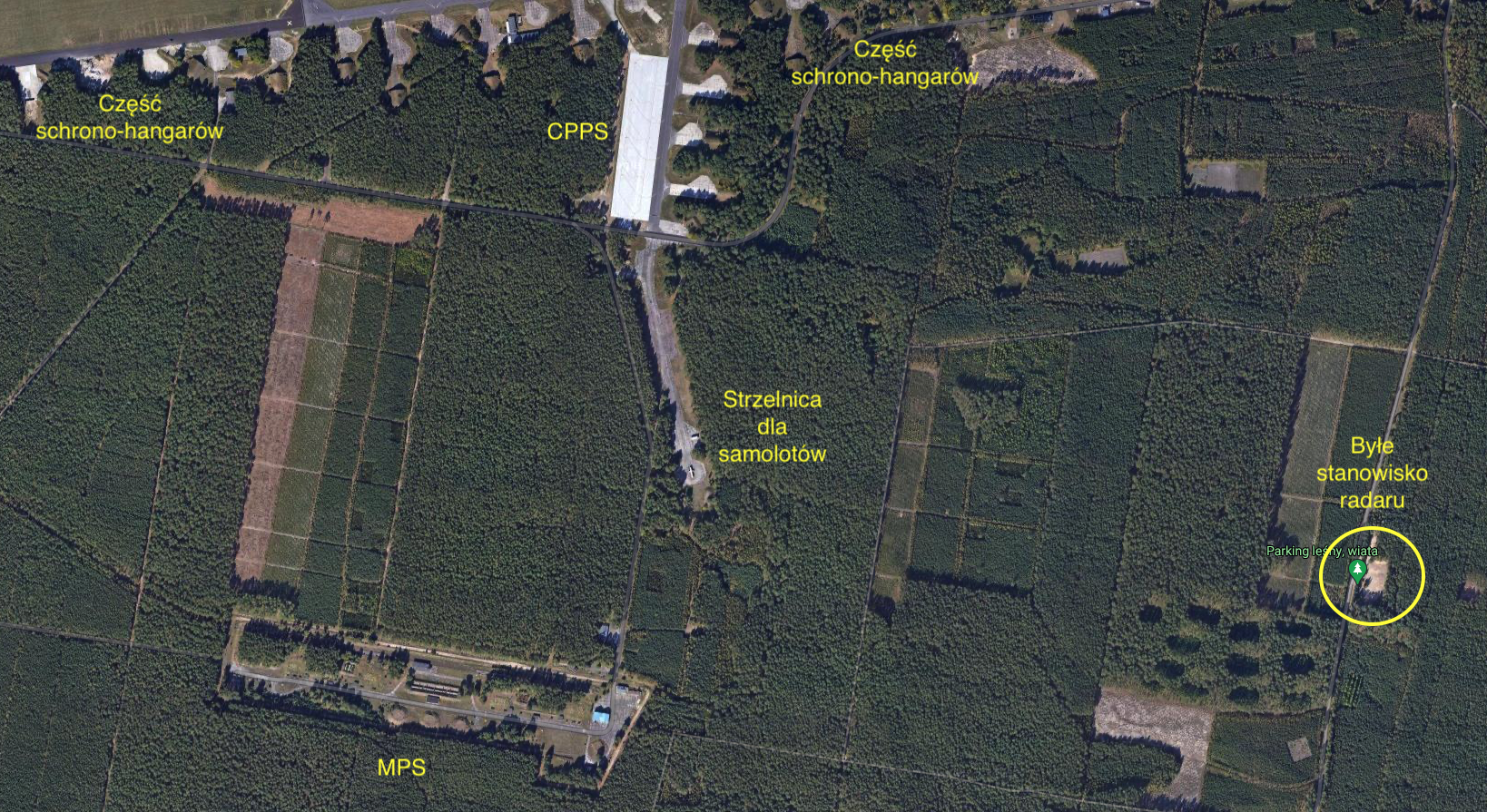
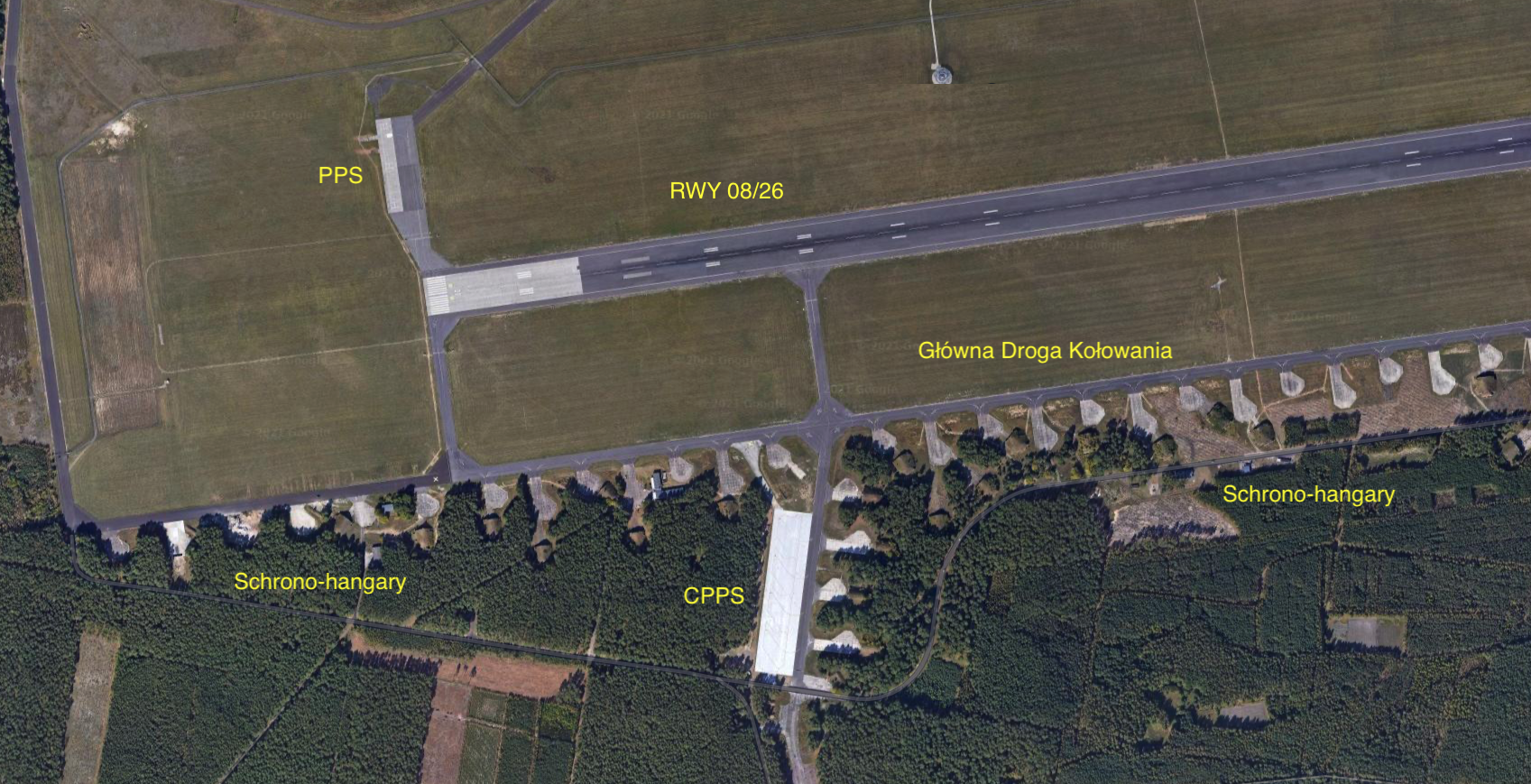
In the first half of the 70s, 30 shelters and hangars were built at the airport, which still exist today (2013). The shelterhangars have internal dimensions of 24 m x 12 m x 6 m. The doors (gates) were initially opened manually. Later, an Ursus type car or tractor was used (e.g. C 355). Electric drives were also installed. However, electric drives often failed due to moisture. The hangar easily accommodated all combat aircraft of that period operated in Poland; Su-7/20/22, MiG-21/23. The Su-7 aircraft in the hangar left 1.5 m of free space on each side from the wingtips. With the Su-7 properly positioned, another SB Lim-2 could fit into the shelter.
There were two ways to roll the Su-7 into the shelter. An Ursus tractor was placed behind the plane and connected to the plane's main landing gear with ropes. The tractor slowly pulled the plane inside. At that time, the technician was steering the plane using a guide, and the technician's assistant was standing on the ladder with his hand on the brake. After the operation was completed, the tractor drove out through the rear gate. The second method was to place the tractor facing the nose of the plane. The reins were attached to the front leg of the plane and the front hitch of the tractor. An experienced driver pushed the plane inside without any problems. But he really must have been experienced, because he had to constantly see the wingtips and the top of the vertical tail.
In each shelter, a side room always contained weapons (bombs, rockets) secured and sealed in case of an alarm. The Su-7 plane used unguided solid-fuel missiles, so there was no need to perform frequent rocket reloading. All hangars had rooms for mechanics and equipment on the sides. But they were rarely used as social rooms. They usually became handy magazines. In other armies (for example, the GDR) pilots and technicians often stayed there, so they were better managed. There was everything in the hangar: electricity to start the plane, oxygen, air and containers for weapons. The pilot showed up for the flight already dressed in a flight suit. The technician submitted a report and the pilot accepted the plane. The gates were usually already open. The aircraft engine was started inside the hangar. Sometimes, for training, only then were the main gates opened (the rear gates had to be opened earlier). The pilot set off on a signal received from the flight control officer (flight director) via the on-board radio. There was no marshal. In the second half of the 1960s, a group of pilots and technicians underwent special training in Soviet units at CCCP. This training was related to the use of nuclear weapons. The pilots trained the technique of bombing from a climbing flight at low altitude. An imitation nuclear bomb was used for this purpose. A tactical nuclear bomb (called atomic bomb at that time) called 6U-57 was carried on the left node under the fuselage. The right node under the fuselage carried an additional fuel tank. Similarly, additional fuel tanks were carried on the nodes under the wings.
Great importance was attached to mastering navigation over Germany and Denmark (dry), and in reality over the Baltic Sea. The pilot was practically dependent on himself, or possibly on his teammates. The basis was visual and visual navigation. A facilitation would be Western radar stations that would radiate onto the flying plane, and then, in addition to the threat, the pilot could correct his position. In the 1970s, the Polish Army had a perfectly developed network of Western stationary radar stations; their types and purposes. The planes had poor navigation equipment. It had no long-range navigation system. To visualize this, we will present the equipment of the Su-7 BM aircraft; KSIU VHF radio station, 6-channel. Emergency radio station. Automatic radio compass. Beacon signal receiver. SRO-2 M friendly-alien response device. A set of landing equipment without visibility to the ground. Sirena warning device. Radio rangefinder. Autopilot for any speed. ASP-5 ND optical sight, coupled or not, with a radar rangefinder, with a range of 300 - 3,000 m.
In May 1967, the 5th PPLM-Sz took over the heritage of tradition as well as the name and number of the 3rd Assault Aviation Regiment and became the 3rd Pomeranian Fighter-Bomber Aviation Regiment. This happened pursuant to Order No. 07/MON of May 4, 1967, regarding the transfer of historical names and numbers of frontline units to military units and the establishment of annual unit holidays.
The 3rd Pomeranian Fighter-Bomber Aviation Regiment operated in this form for many years. Only in February 1982, he was subordinated to the commander of the 3rd Brandenburg Fighter-Bomber Aviation Division.
For the 3rd PLM-B, the next change occurred only in September 1988, when, due to the end of Su-7 aircraft resources, the regiment was renamed the 3rd Pomeranian Aviation Training and Combat Regiment. Su-7 aircraft, starting with the Su-7 BM version, were gradually withdrawn from service and replaced by TS-11 Iskra aircraft. It was hoped that PZL I-22 Iryda aircraft would be adopted. It should also be emphasized that the importance of the possible participation of the Polish Army in the aggression against the West, and even more so of Poland's use of Russian nuclear weapons, was gradually decreasing. Moscow's distrust towards the Vistula region was growing.
In Poland, Su-7 aircraft were used until June 1990. As a result of the Helsinki Agreements on the reduction of combat assets capable of carrying nuclear weapons, the operation of Polish Su-7 aircraft ended definitively. Some of the planes were scrapped, but a significant number of them went to museums (mainly in 1994).
On March 6, 1992, a ceremonial disbandment of the combat unit took place in Bydgoszcz, during which the regiment's banner was farewelled. On April 30, 1992, the unit, the 3rd Pomeranian Training and Combat Aviation Regiment, ceased to exist. As a result of various events, 1 Su-7 BM (1970), 5 Su-7 BKŁ (1969, 1982, 2 x 1984, 1987) and 1 Su-7 U (from 7 BB-R in Powidz) were lost. . It is worth noting the transfer of one Su-7 BKŁ nb 023 to the Czechoslovak Air Force in exchange for an aircraft accidentally shot down by a Polish pilot of the MiG-21 PFM aircraft in 1971. At the beginning of 1988, the Russians gave Poland one Su-7 BKŁ in exchange for the plane destroyed in 1987 by a Russian pilot during a flight to the repair plant.
Airplanes used in the Regiment in Bydgoszcz; Il-2, Il-10/B-33, Lim-1/2, Lim-5 M, Lim-6 bis, Su-7 BM/BKL/U, TS-11 Iskra.
Written by Karol Placha Hetman
